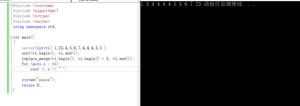pythonA*算法是什么

说明
1、A*算法是静态路网中解决最短路径最有效的直接搜索方法。
2、A*算法是启发式算法,采用最佳优先搜索策略(Best-first),基于评估函数对每个搜索位置的评估结果,猜测最佳优先搜索位置。
A*算法大大降低了低质量的搜索路径,因此搜索效率高,比传统的路径规划算法更实时、更灵活。但A*算法找到的是相对最优的路径,而不是绝对最短的路径,适合大规模、实时性高的问题。
实例
import heapqimport copy
import re
import datetime
BLOCK = [] # 给定状态
GOAL = [] # 目标状态
# 4个方向
direction = [[0, 1], [0, -1], [1, 0], [-1, 0]]
# OPEN表
OPEN = []
# 节点的总数
SUM_NODE_NUM = 0
# 状态节点
class State(object):
def __init__(self, gn=0, hn=0, state=None, hash_value=None, par=None):
'''
初始化
:param gn: gn是初始化到现在的距离
:param hn: 启发距离
:param state: 节点存储的状态
:param hash_value: 哈希值,用于判重
:param par: 父节点指针
'''
self.gn = gn
self.hn = hn
self.fn = self.gn + self.hn
self.child = [] # 孩子节点
self.par = par # 父节点
self.state = state # 局面状态
self.hash_value = hash_value # 哈希值
def __lt__(self, other): # 用于堆的比较,返回距离最小的
return self.fn < other.fn
def __eq__(self, other): # 相等的判断
return self.hash_value == other.hash_value
def __ne__(self, other): # 不等的判断
return not self.__eq__(other)
def manhattan_dis(cur_node, end_node):
'''
计算曼哈顿距离
:param cur_state: 当前状态
:return: 到目的状态的曼哈顿距离
'''
cur_state = cur_node.state
end_state = end_node.state
dist = 0
N = len(cur_state)
for i in range(N):
for j in range(N):
if cur_state[i][j] == end_state[i][j]:
continue
num = cur_state[i][j]
if num == 0:
x = N - 1
y = N - 1
else:
x = num / N # 理论横坐标
y = num - N * x - 1 # 理论的纵坐标
dist += (abs(x - i) + abs(y - j))
return dist
def test_fn(cur_node, end_node):
return 0
def generate_child(cur_node, end_node, hash_set, open_table, dis_fn):
'''
生成子节点函数
:param cur_node: 当前节点
:param end_node: 最终状态节点
:param hash_set: 哈希表,用于判重
:param open_table: OPEN表
:param dis_fn: 距离函数
:return: None
'''
if cur_node == end_node:
heapq.heappush(open_table, end_node)
return
num = len(cur_node.state)
for i in range(0, num):
for j in range(0, num):
if cur_node.state[i][j] != 0:
continue
for d in direction: # 四个偏移方向
x = i + d[0]
y = j + d[1]
if x < 0 or x >= num or y < 0 or y >= num: # 越界了
continue
# 记录扩展节点的个数
global SUM_NODE_NUM
SUM_NODE_NUM += 1
state = copy.deepcopy(cur_node.state) # 复制父节点的状态
state[i][j], state[x][y] = state[x][y], state[i][j] # 交换位置
h = hash(str(state)) # 哈希时要先转换成字符串
if h in hash_set: # 重复了
continue
hash_set.add(h) # 加入哈希表
gn = cur_node.gn + 1 # 已经走的距离函数
hn = dis_fn(cur_node, end_node) # 启发的距离函数
node = State(gn, hn, state, h, cur_node) # 新建节点
cur_node.child.append(node) # 加入到孩子队列
heapq.heappush(open_table, node) # 加入到堆中
def print_path(node):
'''
输出路径
:param node: 最终的节点
:return: None
'''
num = node.gn
def show_block(block):
print("---------------")
for b in block:
print(b)
stack = [] # 模拟栈
while node.par is not None:
stack.append(node.state)
node = node.par
stack.append(node.state)
while len(stack) != 0:
t = stack.pop()
show_block(t)
return num
def A_start(start, end, distance_fn, generate_child_fn, time_limit=10):
'''
A*算法
:param start: 起始状态
:param end: 终止状态
:param distance_fn: 距离函数,可以使用自定义的
:param generate_child_fn: 产生孩子节点的函数
:param time_limit: 时间限制,默认10秒
:return: None
'''
root = State(0, 0, start, hash(str(BLOCK)), None) # 根节点
end_state = State(0, 0, end, hash(str(GOAL)), None) # 最后的节点
if root == end_state:
print("start == end !")
OPEN.append(root)
heapq.heapify(OPEN)
node_hash_set = set() # 存储节点的哈希值
node_hash_set.add(root.hash_value)
start_time = datetime.datetime.now()
while len(OPEN) != 0:
top = heapq.heappop(OPEN)
if top == end_state: # 结束后直接输出路径
return print_path(top)
# 产生孩子节点,孩子节点加入OPEN表
generate_child_fn(cur_node=top, end_node=end_state, hash_set=node_hash_set,
open_table=OPEN, dis_fn=distance_fn)
cur_time = datetime.datetime.now()
# 超时处理
if (cur_time - start_time).seconds > time_limit:
print("Time running out, break !")
print("Number of nodes:", SUM_NODE_NUM)
return -1
print("No road !") # 没有路径
return -1
def read_block(block, line, N):
'''
读取一行数据作为原始状态
:param block: 原始状态
:param line: 一行数据
:param N: 数据的总数
:return: None
'''
pattern = re.compile(r'\d+') # 正则表达式提取数据
res = re.findall(pattern, line)
t = 0
tmp = []
for i in res:
t += 1
tmp.append(int(i))
if t == N:
t = 0
block.append(tmp)
tmp = []
if __name__ == '__main__':
try:
file = open("./infile.txt", "r")
except IOError:
print("can not open file infile.txt !")
exit(1)
f = open("./infile.txt")
NUMBER = int(f.readline()[-2])
n = 1
for i in range(NUMBER):
l = []
for j in range(NUMBER):
l.append(n)
n += 1
GOAL.append(l)
GOAL[NUMBER - 1][NUMBER - 1] = 0
for line in f: # 读取每一行数据
OPEN = [] # 这里别忘了清空
BLOCK = []
read_block(BLOCK, line, NUMBER)
SUM_NODE_NUM = 0
start_t = datetime.datetime.now()
# 这里添加5秒超时处理,可以根据实际情况选择启发函数
length = A_start(BLOCK, GOAL, manhattan_dis, generate_child, time_limit=10)
end_t = datetime.datetime.now()
if length != -1:
print("length =", length)
print("time = ", (end_t - start_t).total_seconds(), "s")
print("Nodes =", SUM_NODE_NUM)
以上就是python A*算法的介绍,希望对大家有所帮助。更多Python学习指路:python基础教程
本文教程操作环境:windows7系统、Python 3.9.1,DELL G3电脑。
以上是 pythonA*算法是什么 的全部内容, 来源链接: utcz.com/z/545606.html






